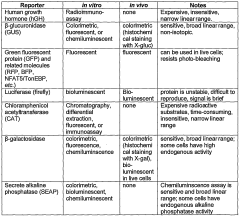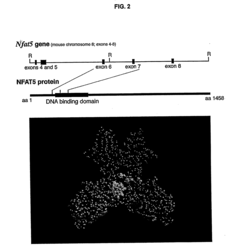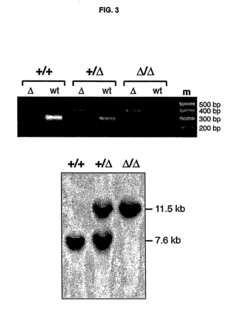Hypertonic Effects: Cellular Osmotic Balance and Implications
Hypertonic Effects Background and Objectives
Hypertonic effects have been a subject of scientific inquiry for over a century, with significant implications for cellular biology, physiology, and medical applications. The study of cellular osmotic balance dates back to the late 19th century when scientists first observed the behavior of cells in solutions of varying concentrations. This field has since evolved, encompassing a wide range of disciplines including biophysics, molecular biology, and clinical medicine.
The primary objective of research in hypertonic effects is to understand the mechanisms by which cells maintain their osmotic balance in the face of external osmotic challenges. This includes investigating the cellular responses to hypertonic stress, such as volume regulation, solute transport, and gene expression changes. Additionally, researchers aim to elucidate the potential therapeutic applications of controlled hypertonic conditions in various medical contexts.
Over the years, technological advancements have significantly enhanced our ability to study hypertonic effects at the molecular level. The development of sophisticated imaging techniques, such as confocal microscopy and fluorescence resonance energy transfer (FRET), has allowed for real-time visualization of cellular responses to osmotic stress. Similarly, advances in genomics and proteomics have enabled researchers to identify key genes and proteins involved in osmotic regulation.
The study of hypertonic effects has far-reaching implications across multiple fields. In medicine, understanding cellular responses to hypertonicity is crucial for developing treatments for conditions such as dehydration, diabetic ketoacidosis, and cerebral edema. In biotechnology, manipulating osmotic conditions can be used to optimize cell culture conditions and improve the production of biopharmaceuticals. Environmental science also benefits from this research, as it helps explain how organisms adapt to extreme environments with high salt concentrations.
Current research trends in hypertonic effects focus on several key areas. These include the role of aquaporins in cellular water transport, the signaling pathways involved in osmotic stress responses, and the potential use of hyperosmolar solutions in targeted drug delivery. There is also growing interest in understanding the long-term effects of chronic hypertonic stress on cellular aging and disease progression.
As we look to the future, the study of hypertonic effects is poised to make significant contributions to both basic science and applied research. Emerging technologies, such as single-cell analysis and organ-on-a-chip models, promise to provide even more detailed insights into cellular osmotic regulation. These advancements may lead to novel therapeutic strategies for a wide range of medical conditions and innovative applications in biotechnology and environmental science.
Market Analysis for Hypertonic Solutions
The market for hypertonic solutions is experiencing significant growth, driven by increasing applications in healthcare, biotechnology, and research sectors. The global hypertonic solutions market is projected to expand at a compound annual growth rate (CAGR) of 6.8% from 2021 to 2028, reaching a market value of $3.2 billion by the end of the forecast period.
Healthcare applications dominate the market, with hypertonic saline solutions being widely used in the treatment of various conditions such as hyponatremia, cerebral edema, and cystic fibrosis. The rising prevalence of these disorders, coupled with the growing aging population, is fueling market growth. Additionally, the increasing adoption of hypertonic solutions in wound care management and as osmotic agents in peritoneal dialysis is contributing to market expansion.
In the biotechnology and research sectors, hypertonic solutions play a crucial role in cell culture techniques, protein purification, and osmotic stress studies. The surge in research activities focused on cellular osmotic balance and its implications has led to a higher demand for specialized hypertonic solutions. This trend is expected to continue as advancements in cellular biology and personalized medicine drive further research in this field.
Geographically, North America holds the largest market share, followed by Europe and Asia-Pacific. The dominance of North America can be attributed to its well-established healthcare infrastructure, high healthcare expenditure, and presence of key market players. However, the Asia-Pacific region is anticipated to witness the fastest growth during the forecast period, driven by improving healthcare facilities, increasing research and development activities, and rising awareness about advanced medical treatments.
Key market players are focusing on product innovation and strategic collaborations to gain a competitive edge. The development of novel hypertonic formulations with enhanced efficacy and reduced side effects is a major trend in the market. Furthermore, the increasing focus on personalized medicine is expected to create new opportunities for tailored hypertonic solutions catering to specific patient needs.
Challenges in the market include stringent regulatory requirements for product approval and the potential side effects associated with the use of hypertonic solutions. However, ongoing research aimed at optimizing formulations and delivery methods is expected to address these concerns and further drive market growth.
Current Challenges in Cellular Osmotic Balance
The field of cellular osmotic balance faces several significant challenges that hinder our complete understanding and control of hypertonic effects. One of the primary obstacles is the complexity of cellular membrane dynamics under varying osmotic conditions. Researchers struggle to fully elucidate the intricate mechanisms by which cells maintain their volume and internal solute concentrations in response to hypertonic stress.
Another major challenge lies in the development of accurate and real-time measurement techniques for intracellular osmolarity. Current methods often rely on indirect measurements or invasive procedures that may alter the cellular environment, potentially skewing results. This limitation hampers our ability to precisely monitor osmotic changes within living cells, particularly during rapid fluctuations in extracellular tonicity.
The heterogeneity of cellular responses to hypertonic conditions presents an additional layer of complexity. Different cell types and even individual cells within the same population may exhibit varying degrees of osmotic tolerance and adaptation mechanisms. This diversity makes it challenging to develop universally applicable models and therapeutic strategies for managing hypertonic effects across diverse biological systems.
Furthermore, the long-term consequences of repeated or prolonged exposure to hypertonic environments remain poorly understood. While acute responses to osmotic stress have been extensively studied, the cumulative effects on cellular function, gene expression, and overall tissue health over extended periods are not fully characterized. This gap in knowledge is particularly relevant in clinical settings where patients may experience chronic hypertonic conditions.
The interplay between osmotic balance and other cellular processes, such as metabolism, signal transduction, and protein folding, adds another dimension of complexity. Researchers face difficulties in isolating the specific effects of hypertonic stress from other cellular responses, as these processes are often interconnected and mutually influential.
Lastly, translating findings from in vitro studies to in vivo applications remains a significant hurdle. The controlled environment of laboratory experiments may not fully replicate the complex, dynamic conditions found in living organisms. This discrepancy can lead to challenges in developing effective treatments or interventions based on cellular osmotic balance principles for real-world applications.
Existing Hypertonic Effect Management Strategies
01 Hypertonic solutions for osmotic balance
Hypertonic solutions are used to create an osmotic gradient, drawing fluid out of cells or tissues. This effect is utilized in various medical applications to manage fluid balance, reduce swelling, or create a therapeutic environment. The hypertonic nature of these solutions helps maintain osmotic equilibrium in specific physiological contexts.- Hypertonic solutions for osmotic balance: Hypertonic solutions are used to create an osmotic gradient, drawing water out of cells or tissues. This effect is utilized in various medical applications to manage fluid balance, reduce swelling, or create a desired therapeutic effect. The hypertonic nature of these solutions helps maintain osmotic balance in specific clinical scenarios.
- Osmotic drug delivery systems: Osmotic principles are applied in drug delivery systems to control the release of active pharmaceutical ingredients. These systems utilize the osmotic pressure difference between a drug-containing compartment and the surrounding environment to drive drug release at a controlled rate. This approach ensures consistent drug delivery and improved therapeutic outcomes.
- Hypertonic solutions in wound care: Hypertonic solutions are employed in wound care to manage exudate, reduce edema, and promote healing. The osmotic effect of these solutions helps draw excess fluid from the wound bed, creating an environment conducive to healing. This approach is particularly useful in treating chronic wounds and managing heavily exuding injuries.
- Osmotic balance in cell culture and preservation: Maintaining proper osmotic balance is crucial in cell culture and preservation techniques. Hypertonic and hypotonic solutions are used to manipulate cell volume, protect cells during cryopreservation, and optimize culture conditions. These techniques are essential in biotechnology, regenerative medicine, and research applications.
- Hypertonic solutions in ophthalmic applications: Hypertonic solutions are used in ophthalmic treatments to manage various eye conditions. These solutions can help reduce corneal edema, treat dry eye syndrome, and maintain proper intraocular pressure. The osmotic effects of hypertonic solutions in ophthalmology contribute to improved visual outcomes and patient comfort.
02 Osmotic drug delivery systems
Osmotic principles are applied in drug delivery systems to control the release of active pharmaceutical ingredients. These systems utilize the osmotic pressure difference between a drug-containing compartment and the surrounding environment to regulate drug release rates. This approach allows for sustained and controlled drug delivery over extended periods.Expand Specific Solutions03 Hypertonic solutions in wound care
Hypertonic solutions are employed in wound care to manage exudate, reduce edema, and create an optimal healing environment. The osmotic effect of these solutions helps draw excess fluid from the wound bed, potentially aiding in the removal of harmful substances and promoting tissue repair.Expand Specific Solutions04 Osmotic balance in cell culture and preservation
Maintaining proper osmotic balance is crucial in cell culture and preservation techniques. Hypertonic and hypotonic solutions are used to manipulate cell volume, protect cells during cryopreservation, or create specific cellular responses. The careful control of osmotic conditions is essential for cell viability and function in various biotechnological applications.Expand Specific Solutions05 Osmotic agents in medical treatments
Osmotic agents are utilized in various medical treatments to leverage hypertonic effects. These agents can be used to manage intracranial pressure, treat certain types of edema, or facilitate specific diagnostic procedures. The controlled application of osmotic pressure differences allows for targeted therapeutic interventions in diverse clinical scenarios.Expand Specific Solutions
Key Players in Osmotic Balance Research
The field of hypertonic effects and cellular osmotic balance is in a mature stage of development, with ongoing research and applications across various industries. The market size for related technologies and products is substantial, driven by applications in medicine, biotechnology, and pharmaceuticals. The technology's maturity is evident in the diverse range of companies involved, from established pharmaceutical giants like Allergan, Inc. and Genentech, Inc. to specialized biotechnology firms such as Sana Biotechnology, Inc. Academic institutions like The Regents of the University of California and Ghent University contribute significantly to advancing the field. The involvement of companies like Boehringer Ingelheim International GmbH and Life Technologies Corp. further underscores the technology's commercial viability and ongoing innovation in this critical area of cellular biology.
The Regents of the University of California
Genentech, Inc.
Core Innovations in Osmotic Balance Regulation
- A method involving culturing cells under hypertonic stress, contacting them with test agents, and assaying for cell growth or viability to identify candidate anti-cancer or immunosuppressive compounds, using NFAT5/TonEBP polynucleotides or polypeptides, and administering therapeutically effective amounts of inhibitors to treat diseases by modulating the osmotic stress pathway.
- A method involving culturing cells under hypertonic stress, contacting them with test agents, and assaying for cell growth or viability to identify candidate anti-cancer or immunosuppressive compounds, using NFAT5/TonEBP polynucleotides or polypeptides, and administering inhibitors to treat diseases by modulating NFAT5/TonEBP activity.
Regulatory Framework for Osmotic Balance Studies
The regulatory framework for osmotic balance studies plays a crucial role in ensuring the safety, efficacy, and ethical conduct of research in this field. Regulatory bodies such as the Food and Drug Administration (FDA) in the United States and the European Medicines Agency (EMA) in Europe have established guidelines for conducting studies related to cellular osmotic balance and hypertonic effects.
These regulatory frameworks typically encompass several key areas. Firstly, they outline the requirements for preclinical studies, including in vitro and animal models, to assess the potential effects of hypertonic solutions on cellular osmotic balance. These studies are essential for understanding the mechanisms of action and potential risks before progressing to human trials.
For clinical trials involving osmotic balance studies, regulatory bodies mandate strict protocols for patient safety and data integrity. This includes guidelines for subject selection, informed consent procedures, and monitoring of adverse events. Researchers must demonstrate a thorough understanding of the potential risks associated with altering cellular osmotic balance and implement appropriate safeguards.
The regulatory framework also addresses the standardization of methods and measurements in osmotic balance studies. This includes specifications for osmolarity measurements, cell volume assessments, and the characterization of hypertonic solutions. Standardization ensures consistency and comparability of results across different studies and laboratories.
Quality control and assurance measures are another critical component of the regulatory framework. This encompasses guidelines for laboratory practices, equipment calibration, and data management to ensure the reliability and reproducibility of study results.
Ethical considerations are paramount in osmotic balance studies, particularly when involving human subjects. Regulatory bodies require thorough ethical review processes and adherence to principles of beneficence, non-maleficence, and respect for patient autonomy.
The regulatory framework also addresses the reporting and dissemination of study results. This includes guidelines for transparent reporting of methods, results, and potential conflicts of interest. Regulatory bodies may require the registration of clinical trials in public databases to promote transparency and prevent publication bias.
As the field of osmotic balance research evolves, regulatory frameworks are periodically updated to incorporate new scientific knowledge and emerging technologies. This adaptive approach ensures that regulations remain relevant and effective in safeguarding research integrity and patient safety while fostering innovation in the field.
Bioethical Considerations in Osmotic Research
The bioethical considerations in osmotic research are multifaceted and require careful examination. As scientific understanding of cellular osmotic balance and hypertonic effects advances, researchers must navigate complex ethical terrain. One primary concern is the potential for unintended consequences in manipulating cellular osmotic processes. While such research may yield valuable insights and therapeutic applications, it also raises questions about the long-term effects on biological systems and ecosystem balance.
Animal testing in osmotic research presents another significant ethical challenge. The use of animal models is often necessary to understand hypertonic effects on complex organisms, but it must be balanced against the ethical imperative to minimize animal suffering. Researchers must adhere to strict protocols and consider alternative methods where possible, such as in vitro studies or computer simulations, to reduce reliance on animal subjects.
The potential for human experimentation in osmotic research also demands careful ethical scrutiny. Clinical trials involving osmotic manipulations must prioritize patient safety and informed consent. Researchers must be transparent about potential risks and benefits, ensuring that participants fully understand the implications of their involvement. Additionally, the selection of study populations must be equitable, avoiding exploitation of vulnerable groups.
Data privacy and security in osmotic research present further ethical considerations. As studies increasingly rely on large-scale genomic and physiological data, protecting individual privacy becomes paramount. Researchers must implement robust safeguards to prevent unauthorized access or misuse of sensitive information, while also considering the broader societal implications of aggregated data analysis.
The potential for dual-use applications of osmotic research raises additional ethical concerns. Advances in understanding cellular osmotic balance could lead to beneficial medical treatments, but they might also be misused for harmful purposes. Researchers and institutions must establish clear guidelines and oversight mechanisms to prevent the misapplication of their findings.
Lastly, the equitable distribution of benefits from osmotic research is a critical ethical consideration. As potential therapies or technologies emerge from this field, ensuring fair access across different socioeconomic groups and global regions becomes essential. Researchers and policymakers must work together to develop frameworks that promote equitable distribution of scientific advancements, preventing exacerbation of existing health disparities.







